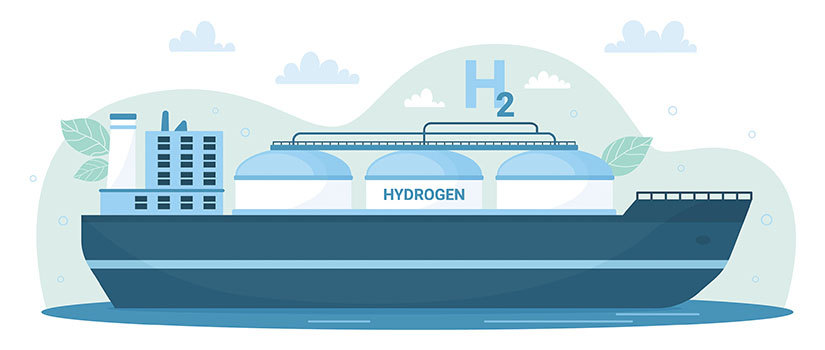Seawater electrolysis is a chemical process that uses an electrical current to split water into hydrogen and oxygen. The method is utilized for generating hydrogen, which can be an alternative fuel to traditional fossil fuels.
The Office of Naval Research (ONR) is interested in improving efficiency and performance of the U.S. Navy fleet, and Chemical Engineering Research Assistant Professor Benjamin Meekins recently began research into using a specific and proven membrane for the seawater electrolysis process to produce hydrogen.
Meekins three-year, $615,000 project began on July 1 and is funded by the ONR and Department of Defense. Co-principal investigators are Chemical Engineering Research Professor Sirivatch Shimpalee and University of South Carolina Educational Foundation Distinguished Professor Brian Benicewicz from the Department of Chemistry and Biochemistry.
Meekins project aims to allow naval vessels the ability to produce hydrogen on-demand using small equipment that could be powered by batteries or renewable energy sources like solar and wind power. The hydrogen could produce ammonia for long-term energy storage, run through a fuel cell to produce power and clean water for drinking, or be burned directly for power generation.
Meekins will develop an efficient and direct electrolysis of seawater to produce hydrogen and oxygen gases by using a polybenzimidazole (PBI)-based proton exchange membrane water electrolyzer. PBI membranes, which were developed by Benicewicz, are known for their stability and tolerance to impurities in water. According to Meekins, PBI membranes will simplify water management, facilitate a wider operating temperature range for higher efficiencies at higher operating temperatures, and enable the separation of hydrogen and oxygen.
“PBI membranes were initially created to use them for high temperature fuel cells, but we were looking for ways to use them for other chemical applications,” Meekins says. “Traditional polymer membranes like Nafion (™) have existed for a long time and are widely used, but they have limitations.”
PBI membranes’ thermal stability allows them to operate at higher temperatures. It creates a different form known as para-PBI, which has a slightly different bond structure. The structure is used in firefighter jackets as part of the protective layer because it’s thermally stable against oxidation.
“Those physical properties will carry over to this project. It’s useful because we know that the membrane will not be corroded or degraded by exposure to chemicals,” Meekins says. “We're using these because we think they have the right properties to perform well and can withstand the corrosive environment that tends to be created doing electrolysis.”
Meekins previous work for electrochemistry successfully showed that PBI membranes enable the direct electrolysis of both dry and wet hydrochloric acid reactions that are applicable to seawater electrolysis.
“It was pure 100% hydrogen chloride in the gas phase, which nobody had done before because every other polymer membrane needs some water in the system. Since it worked well, we started looking at other applications,” Meekins says.
When Meekins saw ONR’s call for seawater electrolysis research, he knew that Nafion (™) membranes are susceptible to poisoning by sodium ions, which drop conductivity and prevent protons to move. Meekins believes that PBI membranes are more resistant to poisoning and will work longer, allowing direct electrolysis of sea water.
“Right now, there’s an extra step to treat the seawater by removing as many ions as possible before electrolyzing the water. You also have to worry about conductivity,” Meekins says. “If you could take the seawater and directly electrolyze it, you cut down the physical and energy footprints.”
Meekins plans to characterize the membrane itself to better understand its conductivity and how it may be affected by salt water. While PBI is a broad material, Benicewicz’s group has developed different varieties with slightly different properties.
“We'll put the PBI membrane in dry and let the water that's there absorb into it and see what it does. We’ll also try starting it with water already loaded into it. Based on the results, we'll narrow it down and move into the actual electrolysis application,” Meekins says.
We are very excited about developing PBI membranes for seawater electrolysis. We think the high temperature capability and chemical stability of PBI will lead to practical production of hydrogen for naval vessels.
- Brian Benicewicz
In addition to Shimpalee and Benicewicz, Meekins team will also work with Claudio Corgnale, Ph.D., president of CC Energy Consulting, who is a techno economic analysis expert.
“Based on our experimental results, he will help us simulate the entire process,” Meekins says. “It will help answer questions like, ‘What does the full system look like?’ ‘What's the cost involved, and how much energy will be used?’ If it's too expensive to be practical, then it’s not good for widespread usage.”
Meekins two goals relate to performance and durability evaluation. The performance goal is to demonstrate a direct seawater electrolyzer that meets or exceeds ONR’s production threshold of 600 grams of hydrogen gas per day with a volume of less than or equal to 0.6 cubic meters. For durability, he is targeting an operation of 200 to 500 hours while maintaining a given density with a stable cell voltage to show its feasibility as a long-term tool.
“I'm looking forward to seeing the results of what the membranes can do. I think they will let us do things that would otherwise not be accessible,” Meekins says. “I'm excited to work with ONR, and if we can do some good work with this, it should lead to a good partnership.”
